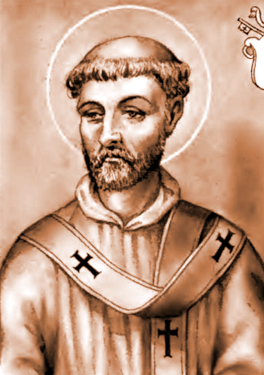Lives of the Saints
Our Models and Protectors
Spiritual Bouquet:
January 11

Saint Hyginus
Pope, Martyr
(74–142)
He was placed in the chair of Saint Peter after the martyrdom of Saint Telesphorus in the year 139. Eusebius informs us that he sat for four years. The church then enjoyed some calm under the mild reign of the emperor Antoninus Pius. Unfortunately, however, several martyrs suffered in his time by the fury of the populace or the cruelty of certain magistrates. The emperor himself never consented to such proceedings. On the contrary, when informed of them by the governors of Asia, Athens, Thessalonica, and Larissa, he wrote to them in favor of the Christians, as is recorded by Saint Justin and Eusebius.
But the devil had recourse to other arts to disturb the peace of God’s church. Cerdo, a wolf in sheep’s clothing, in the year 140, came from Syria to Rome and began to teach the false principles, which Marcion adopted afterward with more success. He impiously affirmed that there were two Gods; the one rigorous and severe, the author of the Old Testament; the other merciful and good, the author of the New, and the father of Christ, sent by him to redeem man from the tyranny of the former; and that Christ was not really born of the Virgin Mary or true man, but such in shadow only and appearance. Our holy pope, by his pastoral vigilance, detected that monster and cut him off from the communion of the church. The heresiarch(1), imposing upon him by a false repentance, was again received, but the zealous pastor, having discovered that he secretly preached his old opinions, excommunicated him a second time.
Another minister of Satan was Valentine, who was a Platonic philosopher, puffed up with the vein opinion of his learning. So full of resentment for another is being preferred to him in an election to a certain bishopric in Egypt, as Tertullian relates, revived the errors of Simon Magus(2), and added to them many other absurd fictions, as of thirty eons or ages, a kind of inferior deities, with whimsical histories of their several pedigrees. Having broached these opinions at Alexandria, he left Egypt for Rome. At first, he dissembled his heresies, but his extravagant doctrines became known by degree. Hyginus, being the mildest of men, endeavored to reclaim him without proceeding to extremities; so that Valentine was not excommunicated before the first year of Saint Pius, his immediate successor.
Saint Hyginus did not sit for quite four years, dying in 142. We do not find that he ended his life by martyrdom, yet he is styled a martyr in some ancient calendars, as well as in the present Roman Martyrology; undoubtedly on account of the various persecutions which he suffered and to which his high station in the church exposed him in those difficult times.
Butler, Alban. The Lives of the Fathers, Martyrs, and Other Principal Saints. Compiled from Original Monuments and Authentic Records, vol. 1. Dublin: James Duffy, 1866.
Edited by Michael Murphy. Used with permission.
Consider purchasing Michael Murphy's book:
Not of Universal Importance: Canceled Saints and Lost Seasons in the Liturgical Calendar Changes of 1969
Notes:
1. A heresiarch, also known as an arch-heretic in Christian theology, is the originator of heretical doctrine or the founder of a sect that upholds such doctrine.
2. Simon Magus, also known as Simon the Sorcerer or Simon the Magician, was a religious figure who clashed with Peter in Acts 8:9-24. The act of simony, or paying for position, was named after Simon, who attempted to buy his way into the Apostles' power.